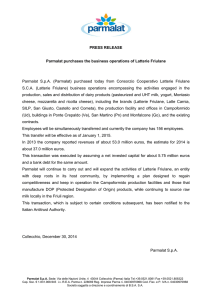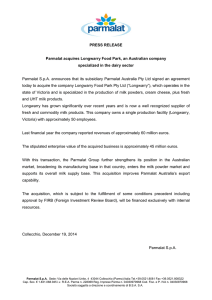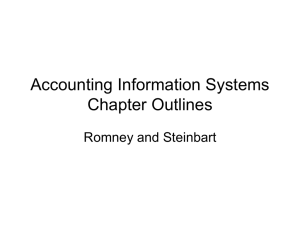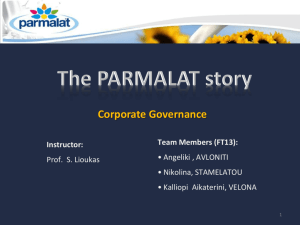Creative Accounting, Fraud and International Accounting Scandals
advertisement
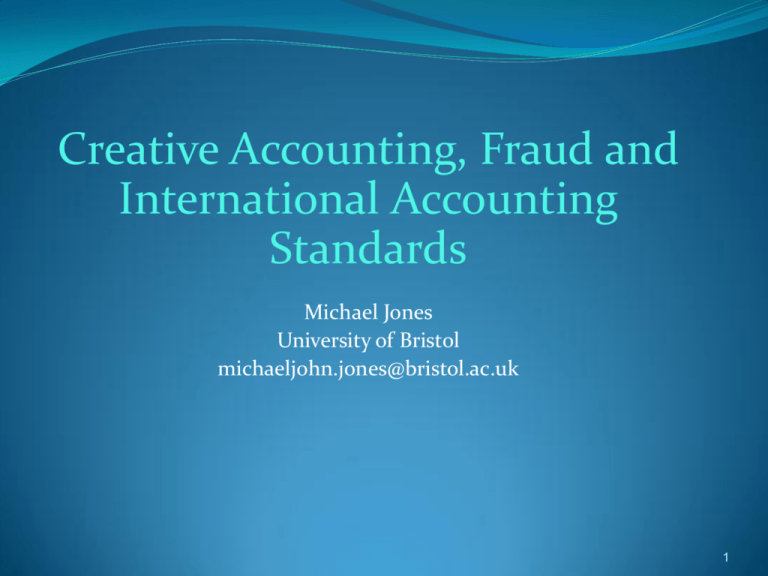
Creative Accounting, Fraud and International Accounting Standards Michael Jones University of Bristol michaeljohn.jones@bristol.ac.uk 1 Overview • Based on Book: Creative Accounting, Fraud and International Accounting Scandals • Investigates nature of creative accounting and fraud • Examines history of accounting scandals • Looks at creative accounting, fraud and accounting scandals in 13 countries worldwide • Focus on political aspects 2 Creative Accounting 3 Two Quotes “How do you explain to an intelligent public that it is possible for two companies in the same industry to follow entirely different accounting principles and both get a true and fair audit report?” M. Lafferty “Every company in the country is fiddling its profits”. I. Griffiths 4 Definitions 1. Fair Presentation Using the flexibility within accounting to give a true and fair picture of the accounts so that they serve the interests of users 5 Definitions 2. Creative Accounting Using the flexibility within accounting to manage the measurement and presentation of the accounts so that they serve the interests of preparers 6 Definitions 3. Impression Management Using the flexibility of the accounts (especially narrative and graphs) to convey a more favourable view than is warranted of a company’s results serving the interests of preparers 7 Definitions 4. Fraud Stepping outside the Regulatory Framework deliberately to give a false picture of the accounts 8 Definitions No Flexibility Regulatory framework eliminates accounting choice Flexibility to give a “true and fair“ view Working within regulatory framework to ensure users’ interests Flexibility to give a creative view Working within regulatory framework to serve preparer’s interests Within regulatory framework Flexibility to give a fraudulent view Working outside regulatory framework Outside regulatory framework 9 Managerial Motivation 1. Personal incentives e.g. Increase salaries through profit-related pay, bonus schemes, shares and share options, job security 2. Market Expectations e.g. Meet analysts’ expectations Profit smoothing 3. Special Circumstances e.g. Manage gearing New issues Mergers and acquisitions Decrease regulatory visibility New management team 10 Main Methods A. Creative Accounting 1. Increase Income e.g. premature sales recognition 2. Decrease Expenses e.g. provision accounting capitalisation of interest 3. Increase Assets e.g. enhance goodwill revalue fixed assets 4. Decrease Liabilities e.g. off balance sheet financing reclassifying debt as equity 11 Main Methods B. Fraud 1. Misappropriate assets e.g. steal cash, inventory 2. Fictitious transactions e.g. invent sales or even whole subsidiaries However, creative accounting and fraud overlap 12 Accounting Scandals – Across Time Table 7.1: A Selection of major scams and scandals across time Ancient and medieval i. 1. 2. 3. ii. Seventeenth and eighteenth centuries 4. 5. iii. Cruciform monument, Mesopotamia second millennium BC Medieval merchants, Italy, fourteenth century Cely Family, England , late fifteenth century Africa and India company of Scotland, Scotland, 1695 South Sea Bubble, England, 1720 Nineteenth Century 6. Railway scandals 1840s-1860s , England 7. City of Glasgow bank, Scotland, 1878 iv. Twentieth century: Before Second World War 8. P&O , New Zealand, 1917-36 9. Royal Mail Steam Packet Company , UK, 1931 13 Accounting Scandals – Across Time iv. Twentieth century: Before Second World War (cont.d) 10. Kreuger & Toll, Inc., US, 1932 11. McKesson & Robbins, US, 1937 v. Twentieth century: 1945-1980s 12. Reid Murray, Australia, 1963 13. H.G. Palmer, Australia, 1965 14. Associated Electrical Industries takeover by General Electric Company, UK, 1967 15. Minisec, Australia, 1971 16. Equity Funding Corporation of America, US, 1973 17. Cambridge Credit, Australia, 1974 18. Renouf and Judge Corporations, New Zealand, 1980s 14 Major Accounting Cases Covered AUSTRALIA GERMANY Adelaide Steamship Bond Corporation Harris Scharfe One.Tel HIH Insurance Co-op Balsam Bremer Comroad Flowtex Philip Holzmann Vulkan Verbund CHINA GREECE Shenzhen Yuanye Great Wall Fund Raising Hongguang Daqing Lianyi Kangsi Group Lantain Gufen Zhengzhou Baiwen Bank of Crete Dynamic Life Esta Finance 15 Major Accounting Cases Covered INDIA NETHERLANDS Satyam Fokker Royal Ahold RSV ITALY SPAIN Parmalat Afinsa and Forum Filatelico Banesto Caja Rural de Jaen Gescatera Promotura Social De Viviendas JAPAN SWEDEN Fuji Sash Kanebo Livedoor Morimoto-gumi Nikko Cordial Riccar Sanyo Special Steel Sawako Yamaichi Securities Yaohan Japan ABB Fermenta Prosolvia Skandia 16 Major Accounting Cases Covered UK US Mirror Group Polly Peck Bank of Credit and Commerce International Adelphia Communications Bear Stearns Bre-X Minerals California Micro Devices Enron HealthSouth Lehman Brothers Madoff Securities International Tyco International WorldCom 17 Countries and Authors Australia China Germany Greece India Italy Japan Netherlands Spain Sweden UK US Garry Carnegie and Brendan O’Connell Catherine Chen, Yuanyuan Hu, Jason Xiao Hansrudi Lenz Maria Krambia-Kapardis, George Kontos, Nikolaos Milonas Bhabatosh Banerjee Andrea Melis Kazuyuki Suda Henk Langendijk Nieves Carrera Gunnar Rimmel David Gwilliam, Richard Jackson Charles Mulford and Eugene Comiskey Bank Failures Simon Norton 18 Six Scandals in Depth Australia HIH provisions financial reinsurance goodwill China Zhenzou/Baiwen fraudulent sales related party capitalised and deferred expenses bad debts inflated assets Greece Bank of Crete manipulation of accounting records embezzlement Italy Parmalat redeemable preference shares debtors false sales debts as equity related party overstated assets UK AEI Stocks Contracts Debts US Enron Loans as sales Off-balance sheet subsidiaries Swapping sales 19 HIH • Australian second largest insurance company • Collapsed in 2001 • Three accounting issues: i. Underprovided for future expected claims ii. Reinsurance which did not transfer risk (e.g., side letters) iii. Losses transferred to goodwill account • Executives prosecuted • Anderson’s criticised for lack of independence, failure of audit committee and consultancy work • Corporate Law Economic Reform Program Act 2004 20 Zhenzhou Baiwen • • • • Company dealing with household appliances Fifth largest company in China in 1997 2002 ran into serious problems Accounting Issues: i. Fraudulent sales ii. Misused raised capital iii. Capitalised expenses iv. Deferred expenses v. Inflated assets vi. Related party provisions 21 Zhenzhou Baiwen • Zhengzhou auditing company fined • Failures of governance i. ii. iii. Board of directors Supervisory board Local government • Consequences i. ii. Revised corporate governance guidelines Changes to Law 22 Bank of Crete • Koskotas, a fraudster • From ages 15-25 in US commits 64 forgery offences as well as forging academic qualifications • 1979 starts work Bank of Crete • 1980 Head of Internal Audit • Steals US $ 1,555,000 and deposits them with Westminster Bank 23 Bank of Crete • Overall embezzles US $32 million • Forges letters and documents to cover tracks • External audit failure • Detected through a special audit • Close connection with Andreas Papandreou, acquitted • Corporate Governance code mandatory Bank of Crete privatised Parmalat • European Enron • 2003 Parmalat defaults on $150 million bond • Accounting Issues i. ii. iii. iv. v. vi. vii. Fictitious sales Double billing Fabrication of operating subsidiaries’ sales Not recording debts Recording debt as equity Overstating assets A forged € 3.95 billion Bank of America cheque 25 Parmalat • Governance Issues i. ii. iii. iv. Tanzi family dominate Board Non-independent non-executive directors Audit committee lacks independence Board of stability auditors ineffective • External auditors failed in monitoring role • Aftermath i. ii. Changes to audit regulations Changes in 8th Directive 26 AEI • UK Company taken over by GEC • Contested bid • AEI forecasts a £10 million profit • GEC published results £4.5 million loss • Political controversy • UK Accounting Standards Steering Committee formed 27 ENRON Highly Successful company Off-balance sheet financing, fictitious income, misreported cashflow Seventh biggest company in US, Bankruptcy Sarbanes Oxley Act Some Themes 1. Overstrong personalities Charismatic persuaders and conmen e.g. In UK, Robert Maxwell and Asil Nadir In US, Bernie Ebbers at WorldCom In Spain, Mario Conde at Banesto 29 Some Themes 2. Managerial Motivations Cover up bad performance 30 Personal benefits 35 Meet listing requirements 5 30 Some Themes 3. Failure of Internal Control Frequent Examples: At Zhenzou Baiwen failure of supervisory, board, independent directors and state controlled shareholders At Parmalat no independent directors, supervisory board and audit committee failed 31 Some Themes 4. Failure of External Auditors Frequent features: In all seven Chinese cases negligent or complicit auditors At Parmalat auditors failed may have let company post a letter to Bank Comroad surprising failure of auditor to spot a non-existent subsidiary In Spain at Forum auditors did spot some irregularities, but failed to question sales and repurchase agreements 32 Aftermath Short term, generally Loss of share price Company taken over or goes into liquidation Directors jailed or fined Auditors fined 33 Aftermath Longer Term Regulations especially: i. ii. changes in law new Codes of Corporate Governance Continual revisions Gradual increase in laws, regulations and political interference 34 Theoretical model to reduce creative accounting and fraud . Potential for creative accounting and fraud Enhanced by Motives Personal Market Reduced by Environmental opportunities Lax rules and regulations Poor supervisio n Inappropriat e reward and incentive structures Environmental constraints Appropriat e reward and incentive structures Better regulations and code of governance Enforcement and ethics Enhanced supervisio n Harsher penalties Code of ethics 35 How can this be Stopped? Environmental Constraints 1. Appropriate reward and incentive structure 2. Better regulations and codes of Corporate Governance i. ii. iii. iv. Enforcement and Ethics Better enforcement Code of ethics Enhanced supervision 36 Conclusion • Creative Accounting and Fraud perennial problems • Over 12 countries, we study at least 58 different • • • • • • instances of accounting scams Sensational collapses e.g., HIH in Australia , Zhenzhou Baiwen in China, Parmalat in Italy and Enron in US Arise from managerial motivation for personal gain Often promulgated by charismatic persuaders Facilitated by poor corporate governance and failure of external audit Lead to financial loss and increased legislation Darwinian rule of the fittest 37



